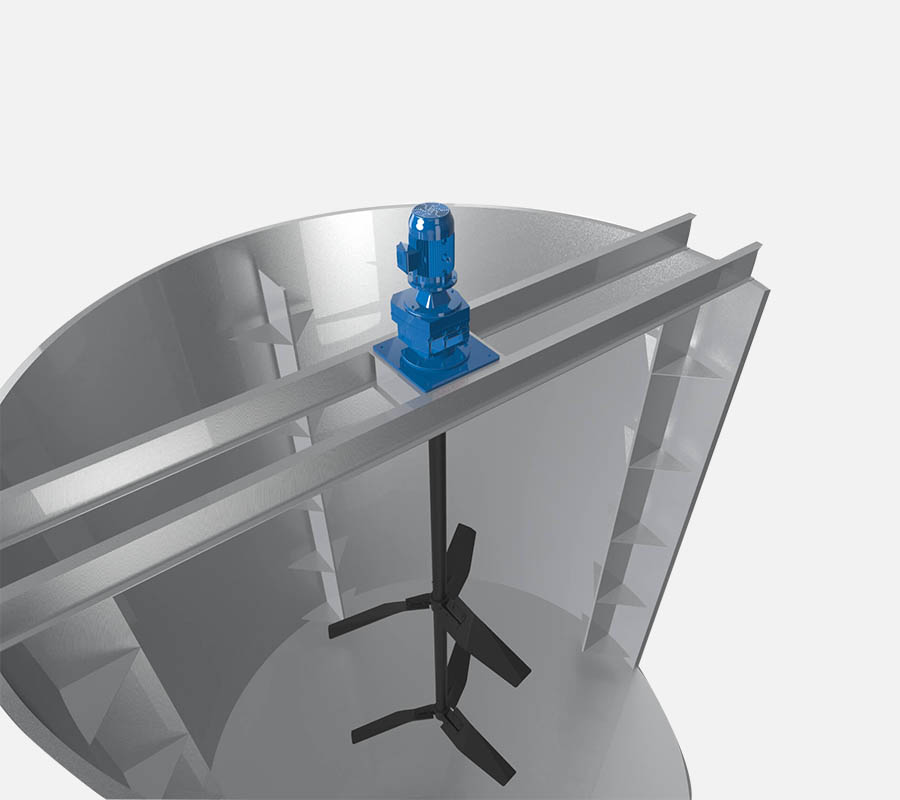What is the speed of agitator mixer?
Agitator designed for low-viscosity products. The speeds available range from 400 to 1,800 rpm, depending on the diameter, with a typical peripheral velocity of between 3 and 15 m/s.
- Type of mixer : Different types of mixers have different optimal speed ranges. For example, axial flow turbines typically operate between 100 and 300 RPM, while fast agitators can reach 750 – 1500 RPM.
- Viscosity of the liquid : Thicker liquids require slower mixing speeds to avoid splashing and inefficient mixing. On the other hand, thin liquids can be mixed at higher speeds.
- Size of the tank : Smaller tanks generally require higher mixing speeds to achieve proper agitation.
- Desired mixing intensity : High-intensity mixing needs faster speeds than gentle blending.
- Specific application : Different processes have specific speed requirements for optimal results.
Therefore, I can’t give you a single answer without more information about the specific agitator mixer you’re interested in.
To help me narrow down the possibilities, could you tell me:
What type of mixer is it (e.g., propeller, paddle, turbine)?
What kind of liquid are you mixing (e.g., water, paint, syrup)?
What is the size of the tank?
What is the desired mixing outcome (e.g., blending, suspending, dispersing)?
The more details you provide, the more accurate and helpful my answer will be.
I look forward to learning more about your specific needs!

What is the speed of the agitator in a mixing tank?
They operate at a low-moderate mixing speed with a peripheral velocity of 2 to 7 m/s.
Dosimix Technologies the optimal speed depends on various factors like the type of mixer, liquid viscosity, tank size, and desired mixing outcome. Please share some details about your mixer and mixing needs, such as :
- Type of mixer: Is it a propeller, paddle, turbine, or something else?
- Liquid properties: Are you mixing water, paint, syrup, or another substance? What’s its viscosity?
- Tank size: How big is the container you’re using?
- Mixing goal: Are you trying to blend ingredients, suspend solids, or achieve some other effect?

Knowing these details will help me pinpoint the appropriate speed range for your specific setup.
For example, if you’re using a simple hand mixer to blend pancake batter in a small bowl, the ideal speed would be significantly slower than an industrial agitator mixing viscous paint in a large vat.
Once you provide more information, I can guide you to the optimal agitating speed for your mixer and ensure successful mixing results!
The speed of the agitator in a mixing tank can vary greatly depending on several factors. Here’s a breakdown to help you understand the range:
Typical ranges :
- Low-viscosity liquids : 50 – 300 RPM (propeller impellers)
- Medium-viscosity liquids: 20 – 100 RPM (paddle or turbine impellers)
- High-viscosity liquids: 5 – 50 RPM (high-shear impellers)
Factors affecting speed :
Impeller type: Different impellers create different flow patterns and require different speeds for optimal mixing.
Liquid viscosity: Thicker liquids need slower speeds to avoid splashing and inefficient mixing.
Tank size: Smaller tanks generally require higher speeds to achieve proper agitation.
Desired mixing intensity: High-intensity mixing needs faster speeds than gentle blending.
Specific application: Different processes have specific speed requirements for optimal results.
Critical speed: Beyond these typical ranges, it’s important to consider the critical speed of the agitator shaft. This is the speed at which the shaft resonates and can lead to excessive vibration and potential damage. Operating close to the critical speed is generally avoided.
To give you a more precise Answer:
- We need more information about your specific mixing tank setup. Please tell us:
- Type of mixer impeller: Propeller, paddle, turbine, etc.
- Liquid properties: Viscosity and type (water, paint, etc.)
- Tank size and shape: Diameter and height
- Desired mixing outcome: Blending, suspending, dispersing, etc.
- With these details, we can tell you a more accurate range for the optimal agitator speed in your specific case.
- Remember, there’s no one-size-fits-all answer, and choosing the right speed is crucial for efficient and effective mixing.


